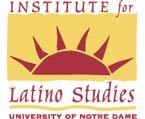
If, as Notre Dames president emeritus, Rev. Theodore M. Hesburgh, C.S.C., once said,The University is where the Catholic Church does its thinking,then Notre Dames Institute for Latino Studies (ILS) is wherethe Church thinks about how its going to integrate what is soon to be the majority of the population of the Church,said ILS associate director Allert Brown-Gort.
The ILS, which strives to help society understand and come to terms with a balanced view of the Latino community through education, research and outreach, has been considering its own role in the conversation about Latino immigrants and the Church, which is almost 50 percent Latino and climbing.
Some groups criticize the Church for embracing immigrants.Others point out that while the number of Latino Catholics is swelling within the Church, the percentage of Latinos who choose to be Catholic is declining.
Thats very worrisome to us,Brown-Gort said.When Latinos give up their Catholic faith and go elsewhere, theyre doing it with a sense of loss.
Hidden, though it may be, in McKenna Hall on campus with a small satellite operation onNotre Dame Avenue, the ILS has gained national visibility.Founded in 1999 by its director Gilberto C á rdenas, Julian Samora Professor of Latino Studies, the ILS began making a name for itself shortly thereafter in Chicago, through its Center for Metropolitan Chicago Initiatives (CMCI).
The CMCI collaborates with the ILS research department on several research projects each year on issues related to families, children and education.Major reports includeThe State of Latino Chicago: This is Home Now,which revealed the Latino population, the fastest growing group in theChicagoarea, is the lead driver for jobs and housing.Now partnering with the Metropolitan Mayors Caucus, the CMCI has launched a first-of-its-kind dialogue on the impact of Latino populationgrowth in theChicagosuburbs.
These Latino Suburban Roundtablesbring togethersuburban mayors and community and faith leaders to have a candidconversation on the issues of immigrant integration, education andhousing,said Sylvia Puente, CMCI director.More importantly, they are opening doors and dialogue topromote an understanding of the assets that suburban Latinos bring to the region.
Currently putting finishing touches on its annual Hispanic Housing Report, the ILS last year revealed that Hispanic renters and potential homeowners continue to face inequitable treatment and problems of affordability.
Outright discrimination against Hispanic homebuyers and renters is still an all-too-common problem which requires continued monitoring and increased efforts to enforce fair housing laws,said Timothy Ready, director of research for the ILS and author of the 2006 report.
ILS publications are available on the Web at http://www.nd.edu/~latino/research/publications.htm .
Other ILS units include Migration and Border Studies, Center for Latino Spirituality and Culture, Center for the Study of Latino Religion, and Letras Latinas, the institutes literary program.The ILS also serves as headquarters for the “Inter-University Program for Latino Research”: (IUPLR), which is a consortium of 23 institutions that unites scholars from a variety of disciplines to conduct policy-relevant research on Latinos, including a campaign to promote health education on Latinos and obesity.
Letras Latinas is an important ILS presence in the humanities.Director Francisco Aragón is the founding editor and director of Momotombo Press, which supports emerging Latino writers, and also founded the institutes Andrés Montoya Poetry Prize, the first contest in theUnited Statesto encourage emerging Latino poets.
ILS initiatives have helped get Notre Dame routinely ranked among Hispanic Business MagazinesTop 25 Colleges for Latinos,but Brown-Gort says the institute is not just a haven for Latinos.
One of the things were proudest of is that about half of the students in both our minor and our supplementary major are non-Latino,he said.They understand that knowing about this population can give them an edge in business, pre-med or sociology.Were here to serve campus because there are very few disciplines that are not going to be impacted by the rapid growth of Latinos in theU.S.
Proud of what the institutes faculty and staff have accomplished and appreciative of how Notre Dame has facilitated the progress, Brown-Gort says in deference to the reputation of the University, the ILS does not practice advocacy, but strives to provide the most reliable and up-to-date information possible,so people can make up their own minds.And, he feels the ILS is helping bring Notre Damewhich in the late 19 th and early 20 th centuries, helped integrate immigrant children into American lifeback to its roots.
TopicID: 23149